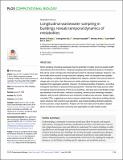Longitudinal wastewater sampling in buildings reveals temporal dynamics of metabolites
Author(s)
Evans, Ethan D; Dai, Chengzhen; Isazadeh, Siavash; Park, Shinkyu; Ratti, Carlo; Alm, Eric J; ... Show more Show less
DownloadPublished version (5.003Mb)
Publisher with Creative Commons License
Publisher with Creative Commons License
Creative Commons Attribution
Terms of use
Metadata
Show full item recordAbstract
Copyright: © 2020 Evans et al. This is an open access article distributed under the terms of the Creative Commons Attribution License, which permits unrestricted use, distribution, and reproduction in any medium, provided the original author and source are credited. Direct sampling of building wastewater has the potential to enable “precision public health” observations and interventions. Temporal sampling offers additional dynamic information that can be used to increase the informational content of individual metabolic “features”, but few studies have focused on high-resolution sampling. Here, we sampled three spatially close buildings, revealing individual metabolomics features, retention time (rt) and mass-to-charge ratio (mz) pairs, that often possess similar stationary statistical properties, as expected from aggregate sampling. However, the temporal profiles of features-providing orthogonal information to physicochemical properties-illustrate that many possess different feature temporal dynamics (fTDs) across buildings, with large and unpredictable single day deviations from the mean. Internal to a building, numerous and seemingly unrelated features, with mz and rt differences up to hundreds of Daltons and seconds, display highly correlated fTDs, suggesting non-obvious feature relationships. Data-driven building classification achieves high sensitivity and specificity, and extracts building-identifying features found to possess unique dynamics. Analysis of fTDs from many short-duration samples allows for tailored community monitoring with applicability in public health studies.
Date issued
2020Department
Massachusetts Institute of Technology. Department of Biological Engineering; Senseable City LaboratoryJournal
PLoS Computational Biology
Publisher
Public Library of Science (PLoS)